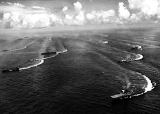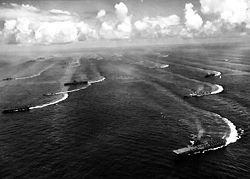
Japan campaign
Encyclopedia

Japanese Archipelago
The , which forms the country of Japan, extends roughly from northeast to southwest along the northeastern coast of the Eurasia mainland, washing upon the northwestern shores of the Pacific Ocean...
, between Allied
Allies of World War II
The Allies of World War II were the countries that opposed the Axis powers during the Second World War . Former Axis states contributing to the Allied victory are not considered Allied states...
forces and the forces of Imperial Japan
Empire of Japan
The Empire of Japan is the name of the state of Japan that existed from the Meiji Restoration on 3 January 1868 to the enactment of the post-World War II Constitution of...
during the last stages of the Pacific Campaign
Pacific War
The Pacific War, also sometimes called the Asia-Pacific War refers broadly to the parts of World War II that took place in the Pacific Ocean, its islands, and in East Asia, then called the Far East...
of World War II
World War II
World War II, or the Second World War , was a global conflict lasting from 1939 to 1945, involving most of the world's nations—including all of the great powers—eventually forming two opposing military alliances: the Allies and the Axis...
. The Japan Campaign lasted from around June 1944 to August 1945.
Air war
Periodic air raids on JapanAir raids on Japan
During World War II the Allied forces conducted many air raids on Japan which caused extensive destruction to the country's cities and killed over 300,000 people. These attacks began with the Doolittle Raid in mid-April 1942, but did not resume until June 1944 when United States Army Air Forces ...
were the first attacks undertaken by the Allied forces. In late 1944, these raids were followed by a major strategic bombing campaign against Tokyo
Bombing of Tokyo in World War II
The bombing of Tokyo, often referred to as a "firebombing", was conducted by the United States Army Air Forces during the Pacific campaigns of World War II. The U.S. mounted a small-scale raid on Tokyo in April 1942, with large morale effects...
and other military and civilian targets throughout Japan
Japan
Japan is an island nation in East Asia. Located in the Pacific Ocean, it lies to the east of the Sea of Japan, China, North Korea, South Korea and Russia, stretching from the Sea of Okhotsk in the north to the East China Sea and Taiwan in the south...
.
Land and sea battles
In early 1945, there were two major island battles:- The Battle of Iwo JimaBattle of Iwo JimaThe Battle of Iwo Jima , or Operation Detachment, was a major battle in which the United States fought for and captured the island of Iwo Jima from the Empire of Japan. The U.S...
(16 February to 26 March): Of approximately 21,000 Japanese defenders, only 216 survived. - The Battle of OkinawaBattle of OkinawaThe Battle of Okinawa, codenamed Operation Iceberg, was fought on the Ryukyu Islands of Okinawa and was the largest amphibious assault in the Pacific War of World War II. The 82-day-long battle lasted from early April until mid-June 1945...
(1 April to 21 June): Of approximately 100,000 Japanese defenders, only 24,455 survived.
There were also two naval battles:
- Operation Ten-GoOperation Ten-Gowas the last major Japanese naval operation in the Pacific Theater of World War II. Other renderings of this operation's title in English include Operation Heaven One and Ten-ichi-gō....
(7 April): Most of the Japanese vessels committed were lost. - The Battle of Tokyo BayBattle of Tokyo BayThe Battle of Sagami Bay was a World War II anti-shipping raid off tip of Bōsō Peninsula on the night of 22 July 1945. It was the last surface action of the war. Destroyer Squadron 61 of the U.S Navy engaged with a Japanese convoy consisting of two freighters and two Imperial Japanese Navy small...
(22 and 23 July 1945): Most of the Japanese vessels committed were heavily damaged or lost.
Allied warships also bombarded several Japanese cities
Allied naval bombardments of Japan during World War II
During the last weeks of World War II, warships of the United States Navy, Britain's Royal Navy and the Royal New Zealand Navy bombarded several cities and industrial facilities in Japan. These bombardments caused heavy damage to several of the factories targeted, as well as nearby civilian areas...
during July and August 1945.
The battles of Iwo Jima and Okinawa foretold what was to be expected when the Japanese Home Islands
Japanese Archipelago
The , which forms the country of Japan, extends roughly from northeast to southwest along the northeastern coast of the Eurasia mainland, washing upon the northwestern shores of the Pacific Ocean...
were attacked. Iwo Jima
Iwo Jima
Iwo Jima, officially , is an island of the Japanese Volcano Islands chain, which lie south of the Ogasawara Islands and together with them form the Ogasawara Archipelago. The island is located south of mainland Tokyo and administered as part of Ogasawara, one of eight villages of Tokyo...
and Okinawa were lost only after extremely fierce resistance was overcome. In both cases the Japanese refused to surrender and there were few survivors. While Japanese losses were extremely high, the Allied
Allies of World War II
The Allies of World War II were the countries that opposed the Axis powers during the Second World War . Former Axis states contributing to the Allied victory are not considered Allied states...
forces paid dearly to take both islands.
Naval operations included a suicidal
Suicide attack
A suicide attack is a type of attack in which the attacker expects or intends to die in the process.- Historical :...
Japanese counteroffensive on 7 April 1945 (Operation Ten-Go), to relieve Okinawa and an Allied campaign to place air and submarine-delivered mines
Operation Starvation
Operation Starvation was an American naval mining operation conducted in World War II by the Army Air Force, in which vital water routes and ports of Japan were mined by air in order to disrupt enemy shipping.-Operation:...
in Japanese shipping lanes. This was illustrated by the naval surface interdiction of Tokyo Bay in July, 1945.
The end

World War II
World War II, or the Second World War , was a global conflict lasting from 1939 to 1945, involving most of the world's nations—including all of the great powers—eventually forming two opposing military alliances: the Allies and the Axis...
ended with the surrender of Japan
Surrender of Japan
The surrender of Japan in 1945 brought hostilities of World War II to a close. By the end of July 1945, the Imperial Japanese Navy was incapable of conducting operations and an Allied invasion of Japan was imminent...
after the atomic bombing of Hiroshima and Nagasaki. Before those two attacks and the Soviet entry into the war, Japan was unwilling to surrender. The firebombing
Firebombing
Firebombing is a bombing technique designed to damage a target, generally an urban area, through the use of fire, caused by incendiary devices, rather than from the blast effect of large bombs....
of Japanese cities resulted in thousands of deaths but did not move the government towards surrender. The Japanese government was clearly prepared to fight an Allied invasion of the home islands as fiercely as they had defended Iwo Jima
Battle of Iwo Jima
The Battle of Iwo Jima , or Operation Detachment, was a major battle in which the United States fought for and captured the island of Iwo Jima from the Empire of Japan. The U.S...
and fought on the Japanese home island of Okinawa
Battle of Okinawa
The Battle of Okinawa, codenamed Operation Iceberg, was fought on the Ryukyu Islands of Okinawa and was the largest amphibious assault in the Pacific War of World War II. The 82-day-long battle lasted from early April until mid-June 1945...
.
The Japan Campaign was intended to provide staging areas and preparation for a possible Allied invasion
Operation Downfall
Operation Downfall was the Allied plan for the invasion of Japan near the end of World War II. The operation was cancelled when Japan surrendered after the atomic bombing of Hiroshima and Nagasaki and the Soviet Union's declaration of war against Japan. The operation had two parts: Operation...
of Japan (Operation Downfall
Operation Downfall
Operation Downfall was the Allied plan for the invasion of Japan near the end of World War II. The operation was cancelled when Japan surrendered after the atomic bombing of Hiroshima and Nagasaki and the Soviet Union's declaration of war against Japan. The operation had two parts: Operation...
) and to support Allied air and naval campaigns against the Japanese mainland. Japan still had a homeland army of about two million soldiers and sufficient resources to cripple an Allied invasion. Consequently, had that invasion been necessary, it most likely would have resulted in a much higher death toll for both sides.
The bombing of Hiroshima and Nagasaki may have saved many lives on both sides by causing the surrender of Japan before an invasion of the Japanese mainland was carried out. Estimates made at the time ran as high as 7,000,000 Japanese civilian and military casualties and as many as 500,000 American military casualties. Debate continues to this day
Debate over the atomic bombings of Hiroshima and Nagasaki
The debate over the atomic bombings of Hiroshima and Nagasaki concerns the ethical, legal and military controversies surrounding the United States' atomic bombings of Hiroshima and Nagasaki on 6 August and 9 August 1945 at the close of the Second World War...
over the necessity of the atomic bombings and their results.
See also
- United States strategic bombing of Japan
- Secret and special weapons in Showa Japan
- Soviet invasion of Manchuria - Launched by the Soviet UnionSoviet UnionThe Soviet Union , officially the Union of Soviet Socialist Republics , was a constitutionally socialist state that existed in Eurasia between 1922 and 1991....
after the first atomic bombing. - Surrender of JapanSurrender of JapanThe surrender of Japan in 1945 brought hostilities of World War II to a close. By the end of July 1945, the Imperial Japanese Navy was incapable of conducting operations and an Allied invasion of Japan was imminent...
- Victory over Japan DayVictory over Japan DayVictory over Japan Day is a name chosen for the day on which the Surrender of Japan occurred, effectively ending World War II, and subsequent anniversaries of that event...
- Japanese war crimesJapanese war crimesJapanese war crimes occurred during the period of Japanese imperialism, primarily during the Second Sino-Japanese War and World War II. Some of the incidents have also been described as an Asian Holocaust and Japanese war atrocities...
- Japanese Instrument of SurrenderJapanese Instrument of SurrenderThe Japanese Instrument of Surrender was the written agreement that enabled the Surrender of Japan, marking the end of World War II. It was signed by representatives from the Empire of Japan, the United States of America, the Republic of China, the United Kingdom, the Union of Soviet Socialist...
- Occupation of Japan

